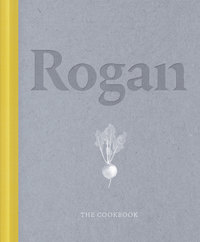
Полная версия
Rogan
Sweet cicely is a real gift from nature; there is no end to the uses for this beautiful, hard-working herb, so do keep an eye out for it, or grow a clump yourself.

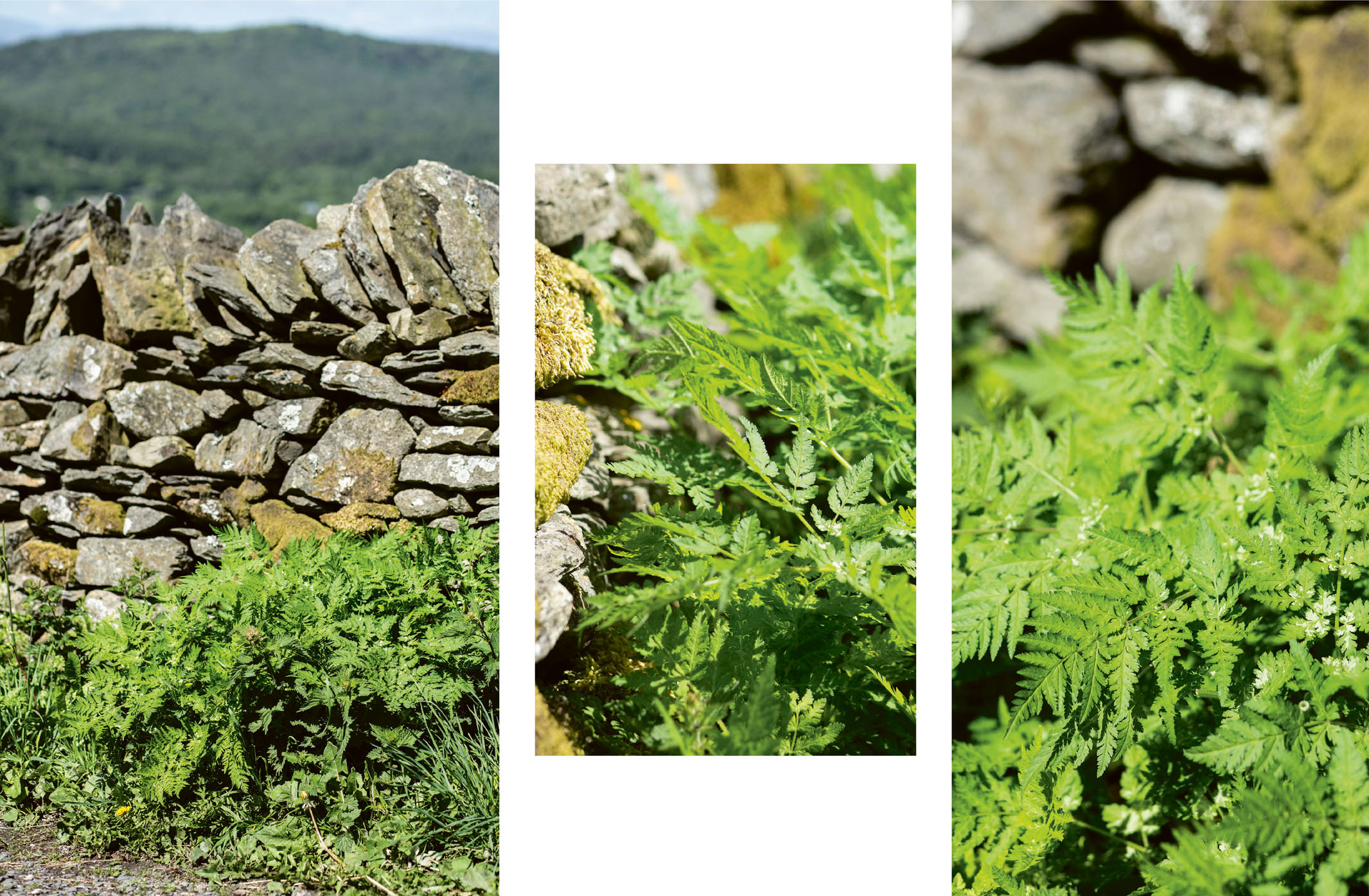
SWEET CICELY AND RHUBARB PICKLED HERRING
Rhubarb is a versatile ingredient that shouldn’t be kept only for desserts, as its sharp tang works so well with meats and strong-flavoured fish. In order to really absorb the full flavour of the rhubarb, cicely and spices, the herring needs to be marinated in the pickling mixture for 24 hours. Here sweet cicely is in its element, not only lending its aromatic flavour to the dish but also cutting through the oiliness of the herring and adding a natural sweetness to the pickle.
SERVES 4, AS A STARTER
Sweet cicely stalk and rhubarb pickled herring
8 rhubarb stalks, juiced in a juicer (should yield about 500ml)
100g sweet cicely stalks (leaves reserved to use below)
20g caster sugar
50ml white wine vinegar
3 cloves
3 allspice berries
4 fresh herrings, cleaned and filleted
Sweet cicely gel
350ml fresh apple juice (shop-bought is fine)
juice of ½ lemon
1½ tsp agar agar
30g sweet cicely leaves
Frisée lettuce emulsion
230g green frisée leaves from the outer lettuce
2 soft-boiled eggs (cooked for 4 minutes)
300ml grapeseed oil
salt, for seasoning
young, yellow frisée from the lettuce centre, chervil leaves, garlic flowers, pak choi shoots, to serve
To make the pickle liquid, bring the rhubarb juice to the boil in a medium saucepan, then remove from the heat and add the sweet cicely stalks, sugar, vinegar, cloves, allspice berries and 2 pinches of salt. Return to the heat and bring to the boil again, then reduce the heat and simmer for 4–5 minutes. Remove from the heat and leave to infuse until it has cooled to room temperature. Strain through a fine sieve and chill. When the pickle liquid is cold, add the herring fillets, cover and leave to marinate in the fridge for 24 hours.
To make the gel, put the apple juice, lemon juice and agar agar in a small saucepan over a high heat and bring to the boil. Once the mixture has come to the boil, pour it into a heatproof container and leave to cool. Once cold, chill in the fridge until set firm – this will only take a few minutes.
Transfer the firm gel to a blender and blitz with the raw sweet cicely leaves until smooth. Pass through a fine sieve and chill until ready to serve.
Bring a large saucepan of water to the boil and blanch the frisée leaves for 1 minute 30 seconds. Remove and refresh in a bowl of iced water. Drain and squeeze out the excess water. Blitz the lettuce with the soft-boiled eggs in a clean blender until smooth, then gradually add the oil until the emulsion has a mayonnaise consistency. Pass through a fine sieve for a smoother texture and season with salt.
Divide the pickled herring among plates, add the sweet cicely gel and frisée lettuce emulsion and sprinkle each serving with the leaves, flowers and shoots.
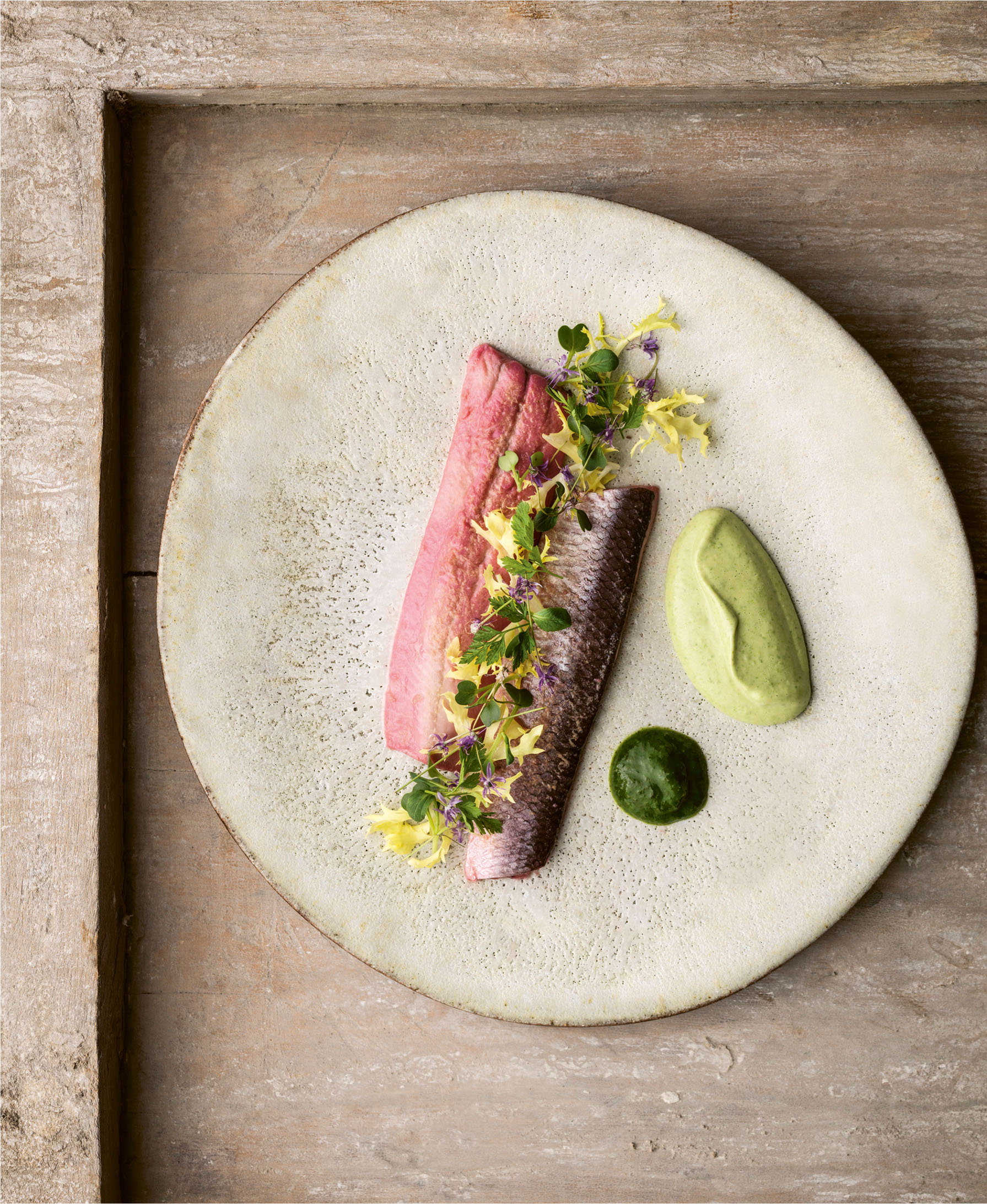
LEEK AND LANGOUSTINES WITH SWEET CICELY AND FENNEL SAUCE
This is one for lovers of aniseed flavours – like me. The combination of fennel, sweet cicely and star anise packs an aniseed flavour punch against the sweet, delicate flavours of the langoustines and cream sauce. The whitecurrants are a lovely addition when in season as they add little bursts of sweetness and freshness. The recipe makes more oil than you will need, but it keeps in the freezer or for 3–5 days in the fridge – it might discolour over time but it’s still fine to use.
SERVES 4, AS A STARTER
Langoustine and cream sauce
12 whole large fresh langoustines
4 tbsp sunflower oil
2 shallots, sliced
1 carrot, sliced
1 celery stick, sliced
1 garlic clove, sliced
1 small leek, sliced
2 tsp tomato purée
1 star anise
1 bay leaf
200ml white wine
25ml Cognac
400ml White Chicken Stock
100ml double cream
juice of ½ lemon
Sweet cicely oil
1 tsp fennel seeds
1 star anise
200ml grapeseed oil
50g spinach
50g sweet cicely leaves and young stalks
Fennel and sweet cicely purée
1 tbsp lemon juice
325g fennel, thinly sliced
75ml double cream, reduced by half over a low heat
40g sweet cicely leaves
Wispy leeks
16 small baby leeks
a pinch of salt
whitecurrants, to serve
Preheat the oven to 180°C/160°C Fan/Gas Mark 4. Bring a large saucepan of water to the boil and blanch the langoustines for 20 seconds. Remove and refresh in a bowl of iced water. When cold, remove the tails from the heads with a short twist and pull. Peel the tails carefully and set the meat to one side. Roast the heads and shells in a roasting tin in the oven for 15–20 minutes.
Warm 2 tablespoons of the sunflower oil in a large, heavy-based saucepan over a medium heat, add all the vegetables and sweat them for 5–6 minutes. Add the tomato purée and cook for a further 2 minutes, stirring continuously. Add the star anise, bay leaf and roasted langoustine shells and heads, deglaze with the alcohol and reduce until almost all the liquid has evaporated. Cover with the chicken stock and bring to the boil, then reduce the heat and simmer for 30 minutes. Remove from the heat and leave to infuse for 2 hours. Strain through a fine sieve into a heavy-based saucepan over a low–medium heat and reduce by half. Add the cream and lemon juice and simmer for a further 5 minutes. Pass through a fine sieve and leave to one side.
While the sauce is infusing, make the sweet cicely oil. Toast the fennel seeds and star anise in a small dry frying pan over a medium heat for 3–4 minutes. Warm the oil in a small, heavy-based saucepan until it reaches roughly 80°C (check with a thermometer) then add the toasted spices. Remove from the heat and allow to infuse for 1 hour. Bring a heavy-based saucepan of water to the boil over a high heat and blanch the spinach for 30 seconds. Remove with a slotted spoon, refresh in a bowl of iced water, drain and squeeze out the excess water. Blitz the cicely, blanched spinach, spices and oil in a blender until smooth. Strain the herb oil through a muslin-lined sieve and chill immediately.
To make the fennel and sweet cicely purée, stir together 250ml water and the lemon juice. Add the finely sliced fennel to the acidulated water and allow to soak for a couple of minutes, then drain and transfer the fennel to a plastic container. Cover with microwave-safe cling film and microwave on full power for 5–6 minutes. After this time check the fennel is soft; if it still has a firm texture, cook it in 1-minute blasts until the fennel is soft and tender. When cooked, squeeze off the excess liquid. Transfer the fennel to a blender along with the reduced cream and sweet cicely leaves. Blitz until smooth and pass through a fine sieve for a smoother texture. Chill to maintain the vibrant green colour. Warm slightly before serving.
Fry the leeks in a non-stick pan over a high heat in 1 tablespoon of the remaining sunflower oil for 2–3 minutes until slightly charred and crispy and season with a pinch of salt. Remove from the pan, add the remaining tablespoon of oil to the same pan and cook the langoustines over a medium heat for 30 seconds on each side.
Drizzle each plate with the sauce and green oil, then divide the leeks and langoustines among the plates with the purée. Finish with whitecurrants that have been slightly warmed in the langoustine roasting tin.
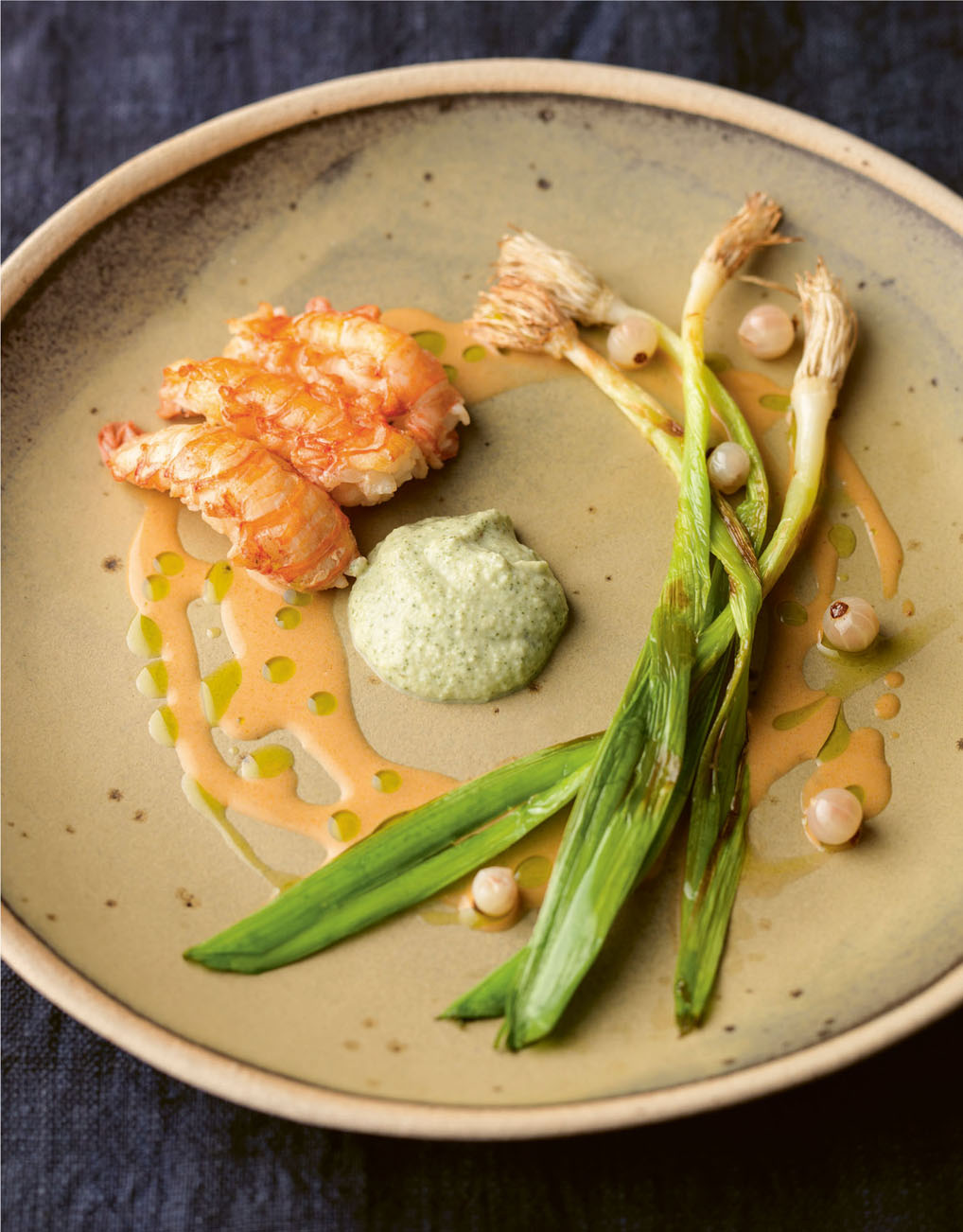
SWEET CICELY CAKE
Sweet cicely might seem an unusual ingredient for a cake, but this herb is a natural sweetener, so you don’t need sugar, and pairing it with star anise highlights its aniseed flavour. The leaves also add a wonderful colour to baking, so slice this cake in front of friends to show off the vibrant green in each piece and serve with a dollop of the creamy aniseed buttercream.
SERVES 10
Sweet cicely cake
200ml whole milk
2 medium eggs
400g runny honey
80g sweet cicely leaves
440g plain flour
2 tsp baking powder
1 tsp ground star anise or 5–6 whole star anise, ground
Star anise buttercream
80g unsalted butter, softened
135g cream cheese
2 star anise, ground
150g icing sugar, sifted
juice of ¼ lemon
Preheat the oven to 190°C/170°C Fan/Gas Mark 5 and line a 900g (2lb) loaf tin with baking parchment.
To make the cake, blitz the milk, eggs, honey and sweet cicely leaves in a blender until the mixture is bright green and smooth. Sift the flour, baking powder and ground star anise into a bowl. Fold the wet ingredients into the dry, transfer to the loaf tin and bake for 45 minutes, or until a skewer inserted into the centre comes out clean. Remove from the oven, leave to cool in the tin, then turn out on to a wire rack to cool completely.
To make the buttercream icing, cream the butter and the cream cheese together in a stand mixer until stiff, light and fluffy. Add three-quarters of the ground star anise and mix well to combine. Turn the speed down to low and gradually add the icing sugar, a tablespoon at a time, until fully incorporated. Remove from the machine and fold the lemon juice into the mixture. Transfer to the fridge for a couple of hours to set.
Put slices of the cake on plates with star anise buttercream, sprinkled with some of the remaining ground star anise.
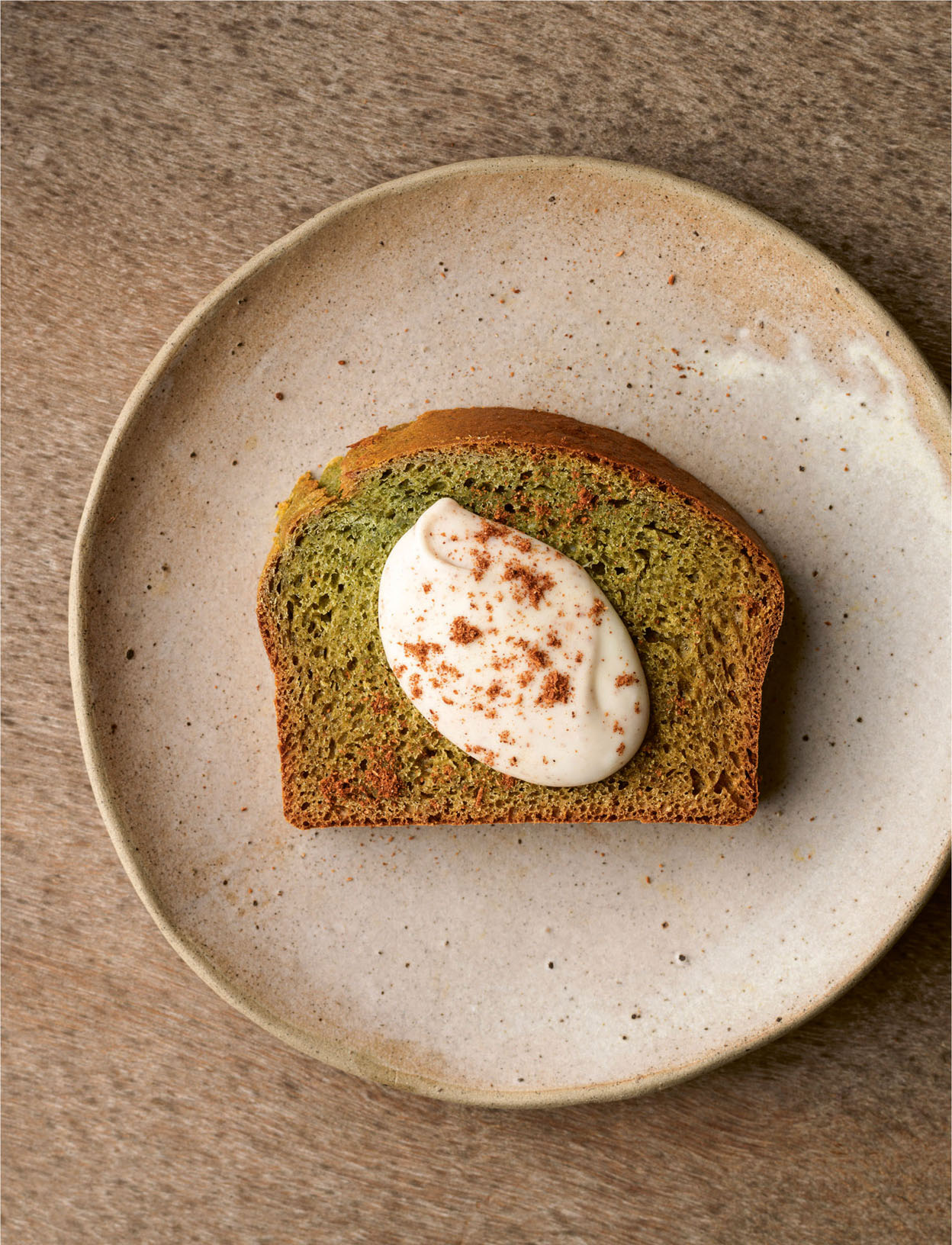
STRAWBERRIES WITH SWEET CICELY SYRUP AND SHEEP’S YOGHURT
Sweet cicely adds an aromatic natural sweetness to the syrup here, which is the perfect complement to the tart yoghurt and ripe strawberries, finished off with the tangy citrusy leaves of sheep’s sorrel. If you think you are not familiar with sheep’s sorrel, think again: it is probably best known to most people as an irritating perennial weed that appears in summer on acidic grasslands, along roadsides and even in domestic gardens. It is widespread, so the leaves can be easily foraged or even cultivated.
SERVES 4
Macerated strawberries
20 strawberries, hulled
juice and zest of ½ lemon
50g caster sugar
½ vanilla pod, split lengthways
Sweet cicely syrup
75g caster sugar
juice of ½ lemon
35g sweet cicely leaves
a pinch of xanthan gum
Sheep’s yoghurt
750g natural sheep’s yoghurt, hung in muslin over a bowl overnight to strain the whey from the curd
sheep’s sorrel, to serve
Slice the strawberries in half lengthways and put them in a bowl. Add the lemon juice and zest, sugar and split vanilla pod and stir gently to coat the strawberries in the mixture. Leave to macerate for 1 hour at room temperature, stirring at 10-minute intervals.
To make the sweet cicely syrup, boil the sugar, lemon juice and 150ml water in a medium, heavy-based saucepan over a high heat until the sugar has dissolved. Remove from the heat and chill (you can do this in a freezer for quick results). Once chilled, add to a blender with the sweet cicely leaves and blitz on high speed until smooth. Pass through a fine sieve. Pour back into a clean blender, add the xanthan gum, blitz to thicken then chill again.
Put a large spoon of sheep’s yoghurt in each bowl, create a well in the top with the back of a spoon and fill with the sweet cicely syrup. Drain the macerated strawberries and arrange them around the outside. Finish with sheep’s sorrel.
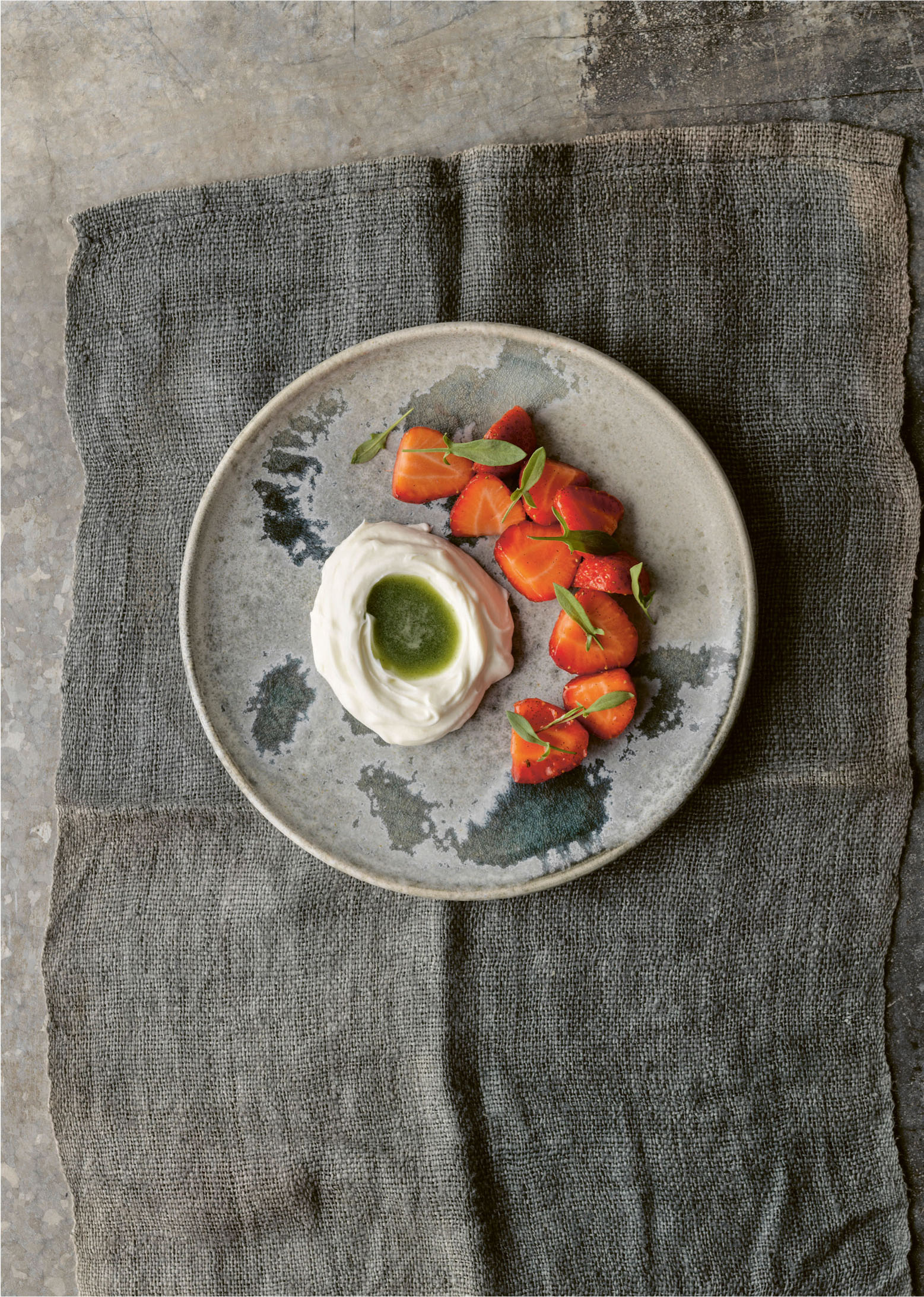
SWEET CICELY ICE CREAM
This is a gently fragrant ice cream, infused simply with sweet cicely. The best way to retain the flavour of this herb is to keep cooking to a minimum, so here it is briefly blanched to preserve its colour, then added to the ice cream mixture at the last minute.
SERVES 4
60g sweet cicely leaves
150ml whole milk
225ml double cream
50g caster sugar
4 egg yolks
juice of ½ lemon
Bring a large saucepan of water to the boil and blanch the sweet cicely leaves for 30 seconds. Remove with a slotted spoon and refresh in a bowl of iced water. Drain and squeeze out the excess water.
In a medium, heavy-based saucepan, bring the milk, 175ml of the cream and 25g of the sugar to the boil. Once the mixture is boiling, remove it from the heat and gradually pour it on to the egg yolks in a large heatproof bowl, whisking constantly to prevent the eggs from scrambling. Return to a clean saucepan and cook over a low–medium heat, stirring constantly, until the temperature of the mixture reaches 80°C (check with a thermometer). Strain the mixture through a fine sieve into a clean bowl, cover and leave to one side.
Put the remaining 25g of sugar in a small, heavy-based saucepan with the remaining 50ml of cream and warm over a low heat. Once the sugar has dissolved, add the mixture to a blender with the blanched sweet cicely and blitz to a purée, then cool it down as quickly as possible by transferring it to a bowl set over ice to maintain the green colour.
Once cool, combine the two mixtures, then add the lemon juice and churn in an ice-cream maker until frozen. Serve at once or transfer to a freezerproof container and store in the freezer until required.
SWEET CICELY POT WITH LEMON VERBENA AND BLUEBERRIES
Lemon verbena is an intense herb that has a floral, citrusy scent that is released when you crush the plant’s leaves. Its flavour is slightly softer than its aroma, but you still get a good lemony tang, without the bitterness of a real lemon. It works beautifully with cream and juicy blueberries. The anise flavour of sweet cicely is the perfect partner to the citrus notes, making this a real celebration of fresh, summery ingredients.
SERVES 4
Sweet cicely pot
50g sweet cicely leaves
450ml whole milk
2 star anise
1 tsp salt
150ml double cream
1 heaped tsp pectin
5 egg yolks
Lemon verbena crème fraîche
500ml double cream
25g fresh lemon verbena
250g crème fraîche
Lemon verbena poached blueberries
100g caster sugar
juice of ½ lemon
10g dried lemon verbena
200g blueberries
young sweet cicely leaves, to serve
Bring a large saucepan of water to the boil and blanch the sweet cicely leaves for 30 seconds. Remove with a slotted spoon and refresh in a bowl of iced water. Drain and squeeze out the excess water. Put to one side.
Put 300ml of the milk in a medium, heavy-based saucepan with the star anise and salt. Warm over a medium heat to 80°C (check with a thermometer), remove from the heat and leave to infuse for 30 minutes. Discard the star anise. Put the milk and blanched sweet cicely in a blender and blitz until very smooth. Strain the mixture through a fine sieve into a clean bowl, cover and leave to one side.
Put the remaining 150ml of milk in another medium, heavy-based saucepan with the double cream and pectin. Warm over a medium heat until it reaches 90°C (check with a thermometer). Remove from the heat and pour this liquid on to the egg yolks in a heatproof bowl, whisking constantly to prevent the eggs from scrambling. When fully incorporated, mix the two liquids together and skim any excess foam produced by the whisking from the top using a dessertspoon. Divide into four serving bowls and chill for about 6 hours until set.
Next, prepare the crème fraîche. Put the cream and the lemon verbena in a medium, heavy-based saucepan over a low–medium heat and simmer until reduced by half. Strain through a fine sieve into a heatproof bowl and discard the lemon verbena. Slowly fold the crème fraîche into the cream, cover and chill until needed.
To poach the blueberries, combine the sugar, lemon juice and dried lemon verbena with 100ml water in a small saucepan. Bring to the boil and remove from the heat. Strain the liquid and discard the lemon verbena. Return the liquid to a clean saucepan and bring to the boil again. Add the blueberries, then remove from the heat and allow to cool to room temperature. Strain the blueberries from the liquid before serving.
Spoon dots of the crème fraîche on to the set sweet cicely. Scatter the poached blueberries in and around the dots so you can see all the colours. Top with the young sweet cicely leaves.

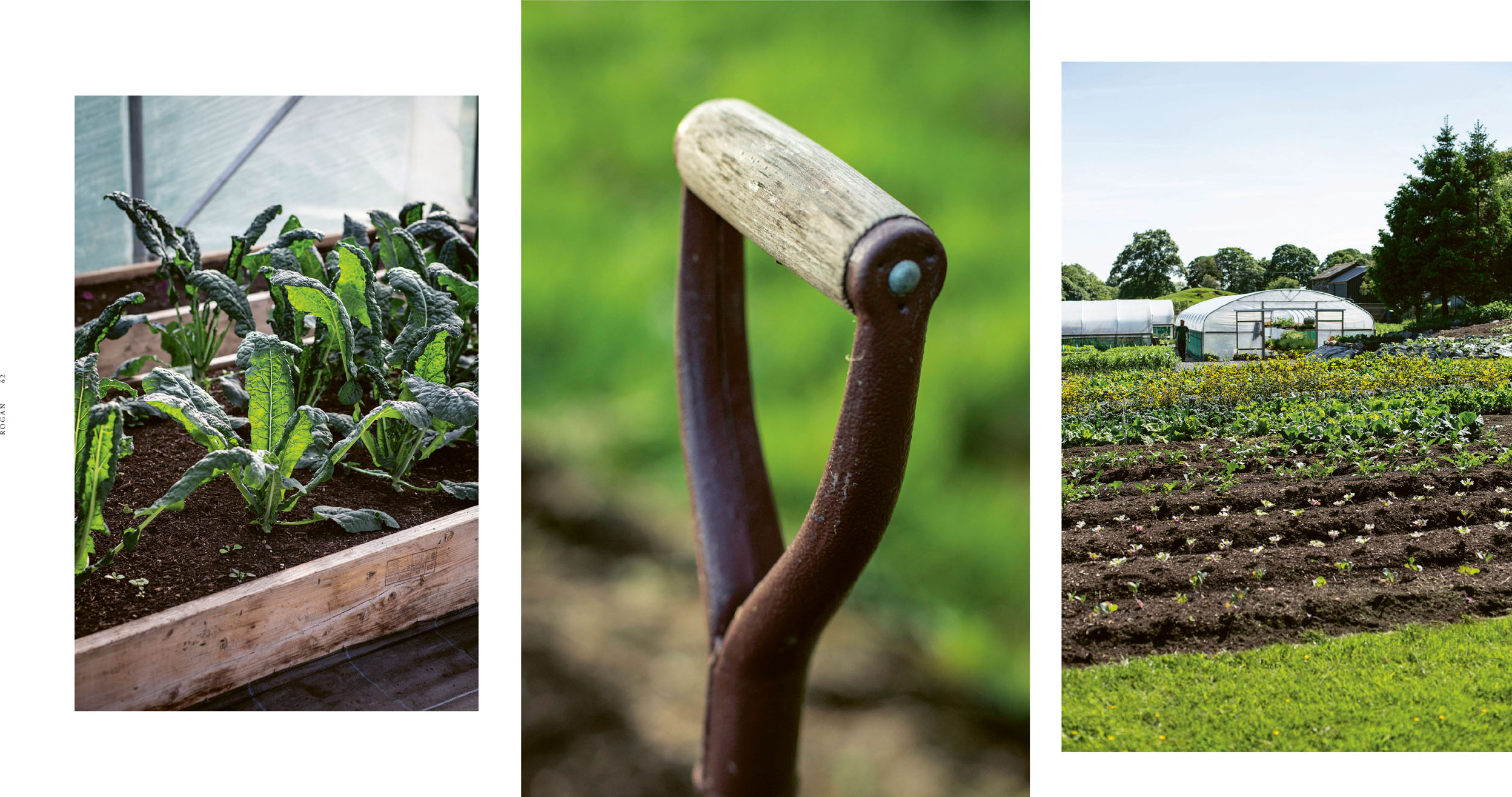
RADISH STEW
There are a few elements to this dish, but the radishes take centre stage. We use many different varieties; each offer something unique, but all are nutritional powerhouses. Use a few varieties if you can – we use Cherry Belle, bright red with crisp, mild, sweet white flesh; Albena, a white-skinned and white-fleshed mild variety; and Viola, with its bright violet skin and crisp white flesh. The truffle granola is one of my favourite recipes; it’s really moreish and if it’s around I can’t help but pick at it. You can make a big batch and store it in an airtight container – but I promise you it won’t hang around for long!
SERVES 4, AS A STARTER
Aubergine purée
1 large aubergine (about 450g)
½ tbsp tahini paste
1 tbsp natural yoghurt
½ tsp roasted chopped garlic
Radish sauce
1 tbsp sunflower oil
1 shallot, sliced
40g button mushrooms, sliced
1½ tsp tomato purée
250g red radishes, thinly sliced
500ml Vegetable Stock
sherry vinegar, for seasoning
5g unsalted butter
Truffle granola
135g honey
35g black truffle oil
35g chilli oil
150g porridge oats
Radishes
12 mixed radishes, such as Cherry Belle, Albena and Viola
2 tbsp rapeseed oil
8 stalks of rhubarb chard (or Swiss chard), stalks removed and cut in half
salt, for seasoning
rapeseed oil, for drizzling
assorted radish flowers and sea purslane, to serve
Preheat the oven to 200°C/180°C Fan/Gas Mark 6.
First, make the aubergine purée. Wrap the aubergine in foil and bake it in the oven for 35–40 minutes until completely soft, then halve it lengthways and scoop out the flesh. Put the flesh in a blender with the tahini, yoghurt and garlic and blitz until smooth. Pass through a fine sieve and season with a pinch of salt.
While the aubergine is cooking, make the radish sauce. Warm the oil in a medium, heavy-based saucepan over a medium heat, add the shallot and sweat for 5–6 minutes, or until translucent, stirring regularly. Add the mushrooms and sweat for a further 3 minutes, or until soft and tender. Stir in the tomato purée and cook for 3–4 minutes. Add the radishes and vegetable stock and bring to the boil. Reduce the heat and simmer for 8 minutes. Remove from the heat and blitz with a hand-held blender until smooth, then strain through a fine sieve. Finish the sauce by seasoning with sherry vinegar and salt and whisking in the butter.
Reduce the oven temperature to 160°C/140°C Fan/Gas Mark 2.
To make the granola, warm the honey, oils and 1 teaspoon of salt in a small saucepan over a low heat until the honey has melted and the salt dissolved. Mix in the oats. Transfer to a baking tray, spread it out in an even layer and bake for 15 minutes, or until golden. Remove from the oven and leave to cool, then break into small pieces. Leave the oven at the same temperature.
Put the radishes on a baking tray, chopping any larger ones in half, season with a pinch of salt, drizzle over half the oil and roast for 10–12 minutes.
Heat the remaining oil in a medium, non-stick saucepan and add the rhubarb chard leaves along with a splash of water. Cook gently until the leaves have wilted and season with a little salt.
Warm the radish sauce. Put a spoon of the purée in the centre of four plates and place the roasted radishes on top. Add the chard, purslane leaves and flowers. Spoon the sauce around the outside and sprinkle with truffle granola. Drizzle with rapeseed oil.
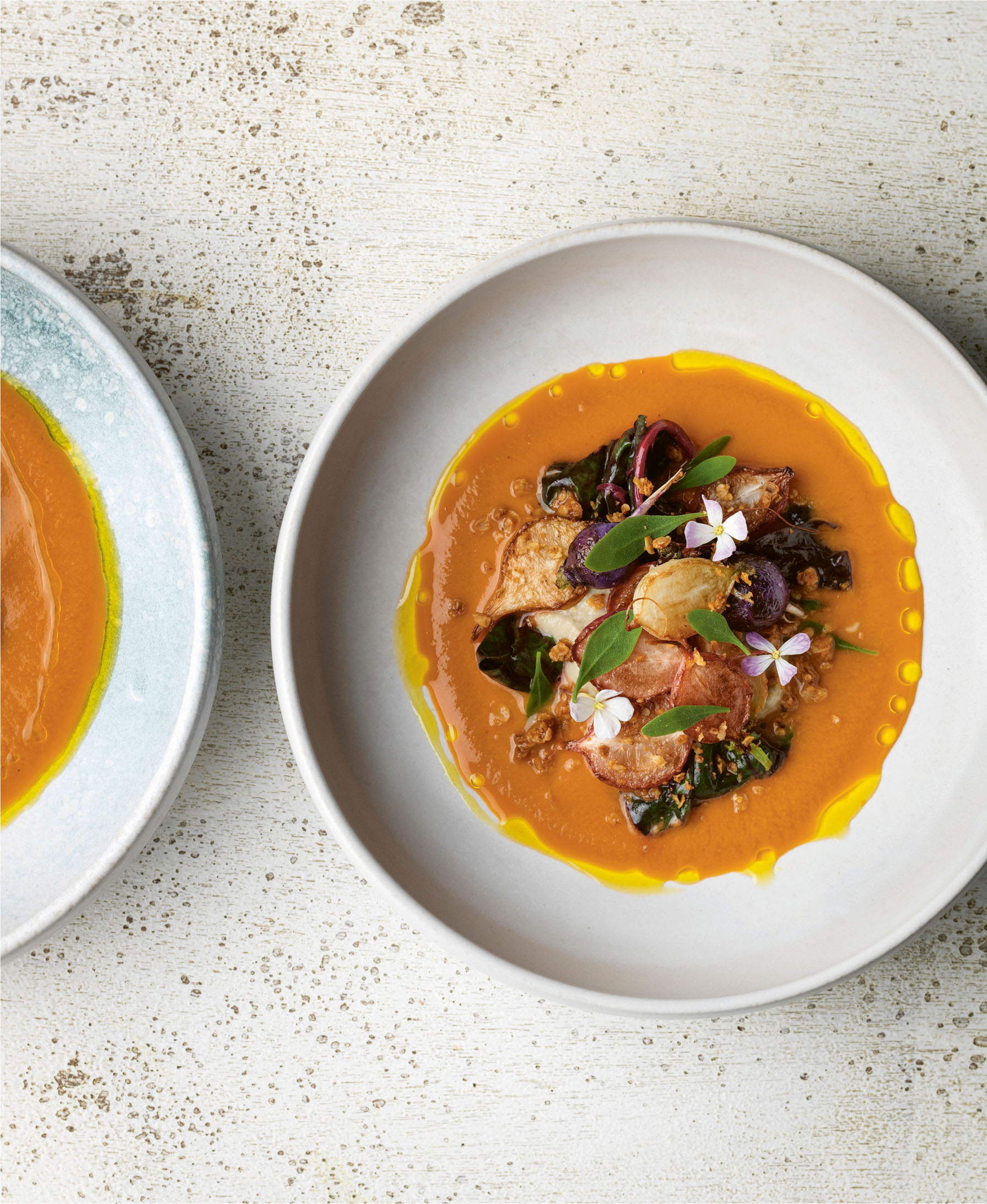
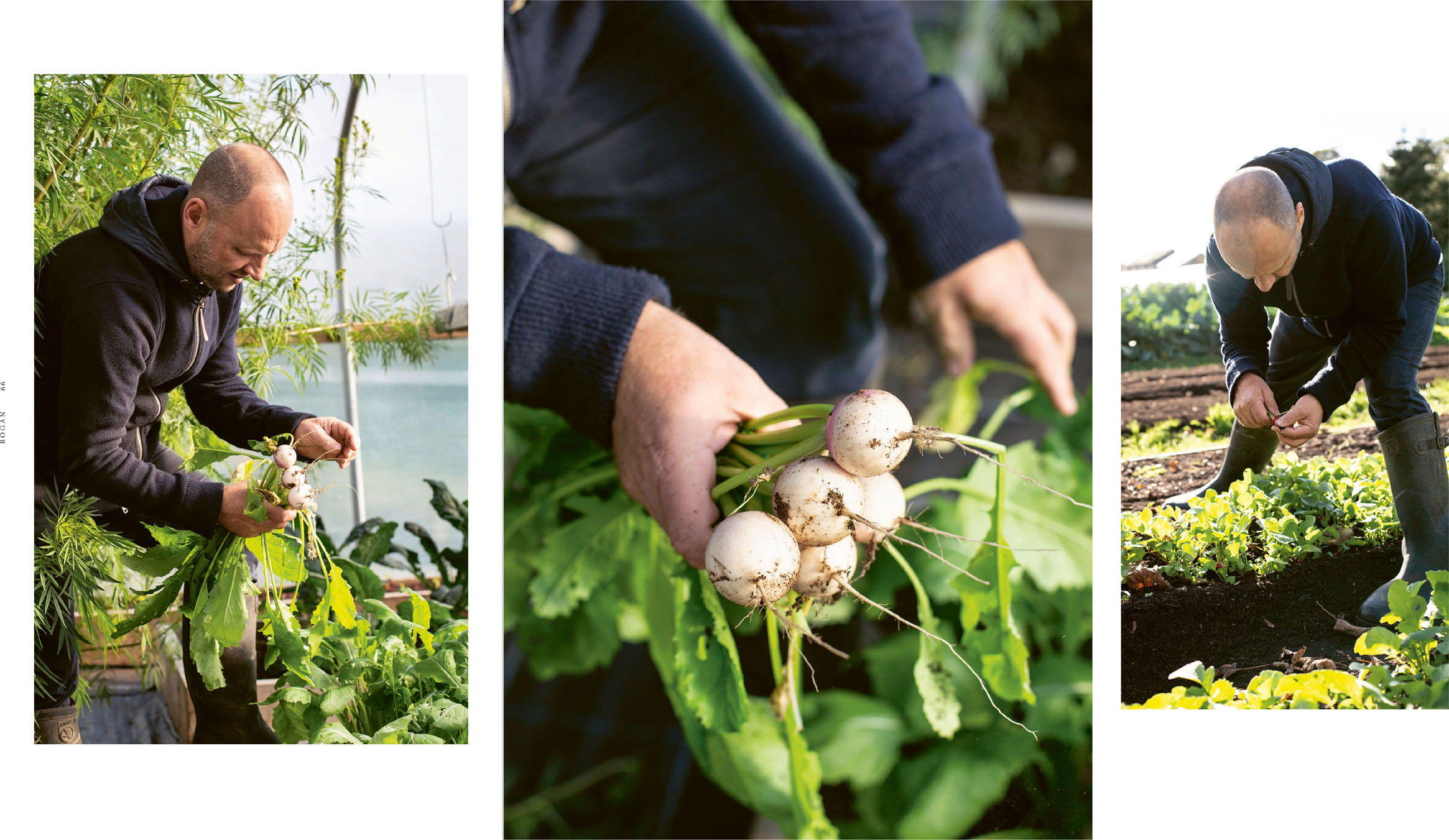
SALT-BAKED TURNIP WITH EGG YOLK AND PORK LARDO
Once Britain’s staple vegetable (until potatoes came along and took its crown), turnip has lost popularity in modern times, but it deserves a resurgence for its versatility and because it is a great source of vitamin C. Baby turnips have a sweet, delicate taste, while larger ones are stronger and more peppery, but even the more mature roots can burst with flavour when cooked in salt dough. This recipe makes a lot of lardo, but it can be frozen once cured. It needs almost 2 weeks to cure, so make it well ahead ready to use or store it in the freezer until you need it.
SERVES 4, AS A STARTER
Pork lardo
1 tsp black peppercorns
1 tsp fennel seeds
1 tsp ground allspice
1 tsp juniper berries
55g coarse sea salt
30g sugar
1kg pork back fat
Slow-cooked egg yolk
4 eggs
Salt-baked turnip
300g coarse salt
500g plain flour, plus extra for dusting
4 large white turnips
Turnip broth
2kg large white turnips, juiced
200ml double cream
50g unsalted butter
2 tsp xanthan gum
juice of 1 lemon
salt, for seasoning
turnip tops and cornflowers, to serve
For the pork lardo, finely grind the spices in a blender or pestle and mortar. Add the salt and sugar and pulse or grind to combine. Rub the spice mix over the pork fat. Wrap the pork fat tightly in cling film and chill for 11 days. Remove the fat from the cling film and brush off the spices. Place it on a wire rack set over a tray and chill, uncovered, for a further 2 days until dry to the touch.
When you are ready to cook the whole recipe, preheat the oven to 140°C/120°C Fan/Gas Mark 1. In a Pyrex dish or high-sided oven tray, cover the eggs with water and bake for 2 hours. Chill in a bowl of iced water to stop them cooking further. Once cool enough to handle, crack the eggs, remove the yolks and leave to one side. Discard the white.
For the salt-baked turnip, increase the oven temperature to 200°C/180°C Fan/Gas Mark 6. In a large mixing bowl, combine the salt, flour and enough cold water to form a dense dough (about 300ml). Dust a work surface with flour and roll out the dough to a thickness of 1cm. Wrap the turnips in the salt dough, covering them completely. Place on a baking sheet lined with baking parchment and bake for 25–30 minutes. Allow to cool to room temperature in the dough, then break open. Peel and grate the turnips into a bowl and leave to one side.




